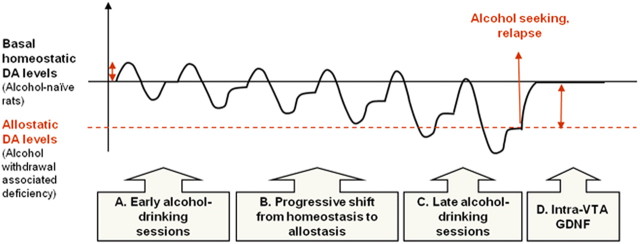Figure 6.
Diagram illustrating a model of allostatic aberration in DA levels in the NAc during prolonged excessive alcohol consumption and its reversal by GDNF. A, Consumption of alcohol during early drinking sessions causes an elevation in DA levels, and this is followed by a period of temporary DA deficiency during withdrawal until DA levels stabilize back to the homeostatic point. B, Repeated cycles of alcohol use and withdrawal cause a progressive transition to an allostatic state in brain reward system. Thus, the basal levels of NAc DA are gradually reduced and stabilize at a lower allostatic point. C, After a prolonged period of excessive drinking and withdrawal cycles, basal NAc DA levels are lowered compared with controls. This might be associated with a negative hedonic/mood state when alcohol is absent, causing craving and alcohol seeking. Alcohol consumption can increase DA levels to levels similar to those of control rats (Weiss et al., 1996), but the levels lapse again to the allostatic levels. D, A single infusion of GDNF into the VTA of rats during withdrawal causes a reversal of the allostatic deviation in DA levels, as well as suppression of alcohol reward seeking, alcohol intake, and relapse (Carnicella et al., 2008, 2009a). The effects of GDNF on alcohol consumption last at least 48 h (Carnicella and Ron, 2009). This diagram has been adapted from a model first published in the study by Koob and Le Moal (2001).

